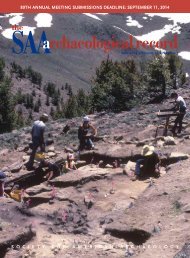SAA
SAA_Record_Nov2015
SAA_Record_Nov2015
Create successful ePaper yourself
Turn your PDF publications into a flip-book with our unique Google optimized e-Paper software.
PROS AND CONS OF CONSULTING COLLECTORS<br />
• Encourage incorporating readings about (e.g., Early 1999;<br />
LaBelle 2003; Pitblado 2014b; Shott 2008) and discussion<br />
of interacting with private collectors into graduate-student<br />
education. We heard comments in our San Francisco<br />
forum from current graduate students and professionals<br />
who felt their graduate programs had perpetuated an<br />
“all collectors are bad” mentality that did not prepare<br />
them for the realities of real-world archaeology. Most<br />
graduate students are exposed to archaeological ethics in<br />
some form. Ensuring that prospective collaboration is<br />
part of those discussions would maximize the chances<br />
that students’ future practice of archaeology and decision<br />
making is rooted in a thorough understanding of the<br />
issues.<br />
• Embrace mechanisms that introduce collectors and professional<br />
archaeologists to one another, so they can learn<br />
first-hand what each has to offer. Tracy Brown, a privatesector<br />
archaeologist in the southeastern U.S., recently<br />
launched a blog called “Can Artifact Collectors and<br />
Archaeologists Find a Way to Get Along and Collaborate<br />
More?” with the tagline “Exploring the Chances for Mutual<br />
Reconciliation, Peace, and Cooperation”<br />
(https://archaeologyreconciliation.wordpress.com).<br />
Brown’s blog features sections devoted to topics such as<br />
“Collectors Submit Questions to Archaeologists” and<br />
vice-versa, and it offers a productive way for nervous professionals<br />
and collectors alike to stick a toe in the water<br />
and get to know one another.<br />
Conclusions<br />
We are deeply grateful to all the contributors to this issue of<br />
The <strong>SAA</strong> Archaeological Record and to those who participated<br />
in our San Francisco <strong>SAA</strong> forum in spring 2015 for sharing<br />
their views on the archaeologist-artifact collector relationship.<br />
Like all people, archaeologists bring to their profession<br />
unique arrays of experiences, often including interactions<br />
with collectors. For many, those experiences have been so<br />
universally positive that it is all but inconceivable that others<br />
could advocate a blanket rejection of such an exceptionally<br />
rich resource. For others, however, negative experiences—<br />
particularly with the extreme end of the collector spectrum<br />
that most archaeologists, avocationals, and responsible collectors<br />
abhor— lead them to see collector-avoidance as the<br />
best and safest possible strategy.<br />
We recognize the apparent logic of the view that archaeologists<br />
can avoid ethical compromise only by avoiding collectors.<br />
Certainly it would seem to follow that if professionals<br />
interact only with other professionals, they will never endanger<br />
the archaeological record. Unfortunately, however, just as<br />
the collector spectrum culminates in the realms of the<br />
unethical and blatantly illegal, so too does the professionalarchaeologist<br />
spectrum— with respect to artifact collection,<br />
interpretation of the record, and regrettably, various other<br />
arenas. As anthropologists know better than anyone, every<br />
group contains bad actors, even when all members have initials<br />
after their names.<br />
Unfortunately as well, for professional archaeologists to<br />
erect an insurmountable wall between themselves and all<br />
collectors, they would be forced to sever all ties with those<br />
who identify as avocational archaeologists and with the many<br />
state and local societies that represent them. Why? Because<br />
in their midst are people who have collected artifacts. Not all<br />
avocational archaeologists collect artifacts and not all collectors<br />
consider themselves to be avocationals. However, the<br />
overlap between the two is sufficiently substantial that to<br />
absolutely ensure collector-free interaction, the only solution<br />
is to avoid the entire population of avocationals. And that,<br />
which strikes us as a would-be travesty and an untenable<br />
approach to our discipline, also leaves only fellow professionals<br />
as trustworthy partners. Yet we have established that<br />
there are bad apples in that bunch, too.<br />
We do not think the world is a perfect place (as we would<br />
construct “perfection”). We do think that “eyes-wide-open” is<br />
the best way to maximize the chances that any relationship<br />
will work to the benefit of those involved, but we also realize<br />
that even the most cautious people occasionally get burned<br />
when they take a chance on one another. We also believe,<br />
however, that rejecting all interaction with any group of people<br />
based on an over-generalized view of how its members<br />
behave is a recipe for isolation and stagnation. We hope that<br />
readers of these essays, whether identifying as a professional<br />
archaeologist, an avocational, and(or) a collector, will conclude<br />
that actively re-building bridges among us offers our<br />
best chance of unraveling and protecting the human story<br />
captured in the material culture that resonates so strongly<br />
with us all.<br />
To close, we encourage anyone interested in helping with<br />
any of the possible proactive steps outlined above, or others<br />
that have not occurred to us but that could advance collaboration,<br />
to contact us.<br />
References Cited<br />
Colwell-Chanthaphonh, Chip<br />
2004 Those Obscure Objects of Desire: Collecting Cultures and<br />
the Archaeological Landscape in the San Pedro Valley of Arizona.<br />
Journal of Contemporary Ethnography 33:571-601.<br />
38 The <strong>SAA</strong> Archaeological Record • November 2015




